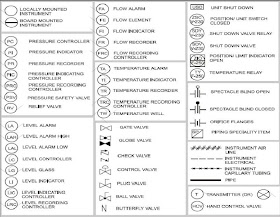Typically instrument abbreviations used in P&IDs consist of two letters: the first indicating the process variable and the second indicating the instrument/controller function. For example, the instrument abbreviation “PI” denotes a “Pressure Indicator”. Occasionally, a third letter is included in the instrument abbreviation to describe a simultaneous function or a special function. For example: the abbreviation “FRC” represents a “Flow Recorder and Controller” which describes both the recording and control functions and the abbreviation “PAL” denotes a “Pressure Alarm Low” which describes
an alarm used in the event of a low pressure condition.
an alarm used in the event of a low pressure condition.
The table below contains some of the instrument abbreviations used in conjunction with P&ID symbols in instrumentation diagrams. I have dealt with some of them before but for the purpose of emphasis and completeness let us go through again. The list here is by no means exhaustive but it is a good starting point for beginners to P&IDs:
Read also: Instrument Abbreviations Used in Instrumentation Diagrams (P&IDs) II
Instrument Abbreviations Used in Instrumentation Diagrams (P&IDs) III
|
Instrument Abbreviation
|
Expansion
|
Functions Performed
|
| FC |
Flow controller
|
Flow measurement and control
|
LC |
Level controller
|
Level control
|
FE
|
Flow element
|
Flow sensor
|
LG
|
Level gauge
|
Level measurement
|
FIC
|
Flow indicator and controller
|
Indicating flow as well as controlling flow
|
| LA |
Level alarm
|
Indicating level alarm
|
FR
|
Flow recorder
|
Recording flow
|
LAH
|
Level alarm high
|
Indicating high level
|
FRC
|
Flow recorder and controller
|
Flow recording; controlling flow
|
LAHH
|
Level alarm high high
|
Indicating very high level
|
FT
|
Flow transmitter
|
Transmitting flow signal
|
LAL
|
Level alarm low
|
Indicating low level
|
| FA |
Flow alarm
|
Indicating flow alarm
|
| LI |
Level indicator
|
Level indication
|
LIC
|
Level indicator and controller
|
Indicating level; controlling level
|
PC
|
Pressure controller
|
controlling pressure
|
TC
|
Temperature controller
|
Controlling/regulating temperature
|
PI
|
Pressure indicator
|
Indicating pressure
|
TI
|
Temperature indicator
|
Indicating pressure
|
PIC
|
Pressure indicator and controller
|
Indicating pressure; controlling pressure
|
TIC
|
Temperature indicator and controller
|
Indicating temperature; controlling temperature
|
PR
|
Pressure recorder
|
Recording pressure
|
TR
|
Temperature recorder
|
Recording temperature
|
PRC
|
Pressure recorder and controller
|
Recording pressure; controlling pressure
|
TRC
|
Temperature recorder and controller
|
Recording temperature; controlling temperature
|
PSV
|
Pressure safety valve
|
Relieving excess pressure in case of high pressure situation
|
TT
|
Temperature transmitter
|
Transmitting measured temperature signals
|
PT
|
Pressure transmitter
|
Transmitting measured pressure signals
|
| TW |
Thermowell
|
Houses temperature sensors
|
RV
|
Relief valve
|
To relieve excess pressure in case of high pressure
|
TY
|
Temperature relay/transducer
|
Converts electrical signals to pneumatic signals
|
| PSH |
Pressure switch high
|
A pressure switch used to indicate high pressure alarm
|
ZI
|
Position/limit indicator
|
Indicates whether a valve is open or close
|
| SDV |
Shut down valve
|
A valve initiating shutdown
|
| ZSC |
Position/unit switch closed
|
Limit switch indicating a valve is closed
|
ZSO
|
Position/unit switch open
|
Limit switch indicating a valve is open
|
SDY
|
Shutdown relay
|
A transducer attached to a shutdown valve
|
| USD |
Unit shutdown
|
Initiate Shut down of a process unit
|
Read also:
Instrument Abbreviations Used in Instrumentation Diagrams (P&IDs) II
Instrument Abbreviations Used in Instrumentation Diagrams (P&IDs) III
Below are some common P&ID symbols used with the instrument abbreviations discussed above for developing P&ID drawings
Instrument Abbreviations Used in Instrumentation Diagrams (P&IDs) II
Instrument Abbreviations Used in Instrumentation Diagrams (P&IDs) III
Below are some common P&ID symbols used with the instrument abbreviations discussed above for developing P&ID drawings
Tag Numbers on P&ID Symbols
Numbers on the P&ID symbols in instrumentation diagrams represent instrument tag numbers. Often these numbers are associated with a particular control loop (e.g., Temperature indicator and controller 123) as shown in the diagram below:
One easy way to learn how to read P&ID drawings and become proficient in it is to look at a lot of Piping and instrumentation diagrams; both simple and complex ones! (please don’t get scared). By so doing, you will eventually become good at reading P&IDs. Any good instrumentation textbook should contain one or two sections dedicated to understanding how to interpret and read P&ID drawings.
For a detailed list of common symbols used in P&IDs checkout:
Common P&ID symbols used in developing instrumentation diagrams

